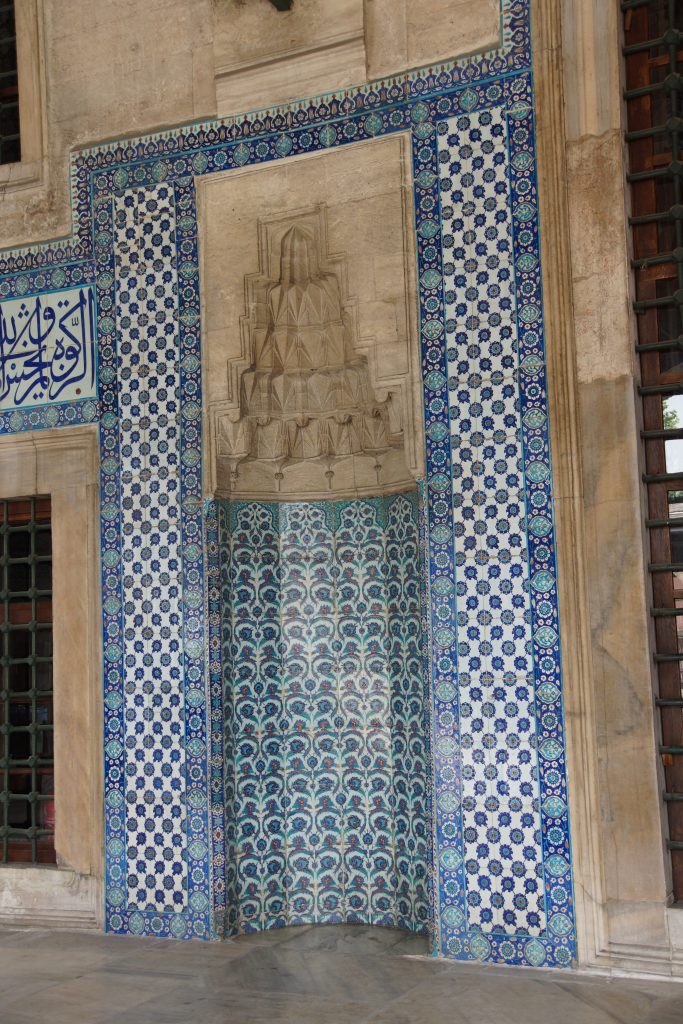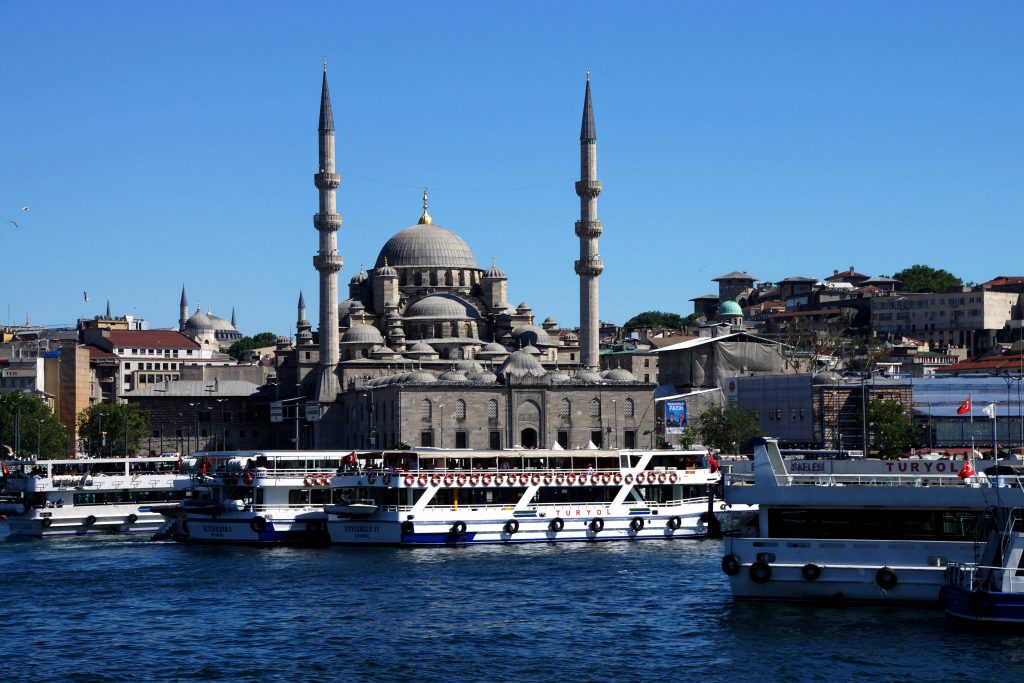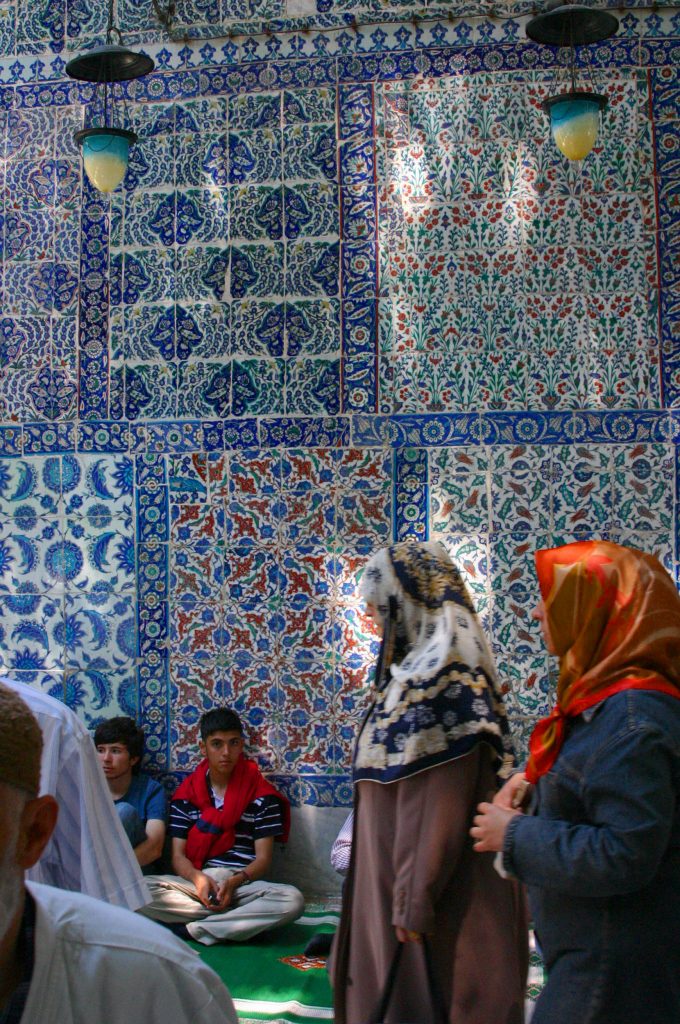The Blue Mosque (Sultanahmet) & Hagia Sophia (Ayasofya) are well-known and are part of the traditional tour of Istanbul’s ancient sites.
Istanbul – Byzantine Marvels and Sultan’s Splendors
The Rest of Istanbul – What You Missed on Your 1st Day Tour
But there are many other mosques deserving a visit. Here’s an overview of my favorites, over 20 years of visits to this city.
Sültan Rustem Pasha Mosque
is an Ottoman mosque near the Grand Bazaar and is my favorite. The Mimar Sinan, the Ottoman imperial architect designed the mosque, which was built between 1563 and 1602, and is deceptively small. Its terrace is elevated above a complex of vaulted shops, whose rents were intended to fund the mosque complex. Its interior is accessible via narrow, twisting corridors. It features a wide variety of floral and geometric tile designs adorning its front façade as well as the mihrab, minbar, and walls, which were made using Armenian bole, a tomato-red pigment that would become characteristic of Iznik pottery. There are around 80 different tile patterns.

Süleymaniye (the Magnificent)
The Süleymaniye Mosque is the second largest mosque in the city, and one of the best-known sights of Istanbul. It’s an Ottoman imperial mosque located on the Third Hill of Istanbul
Another Mimar Sinan mosque, it’s an outstanding example of Ottoman architecture. Built in the 16th century by the renowned architect, it combines the tall, slender minarets characteristic of Ottoman design with large domed structures supported by half domes in the style of Hagia Sophia. Süleyman the Magnificent converted Justinian’s church into the Aya Sofya mosque
The Süleymaniye Mosque plays to Süleyman’s ‘second Solomon’ ego. It references the Dome of the Rock, which was built on the site of the Temple of Solomon in Jerusalem. The peristyle is adorned with colonnades.
The interior of the mosque is huge – a nearly square space dominated by a domed structure. There are two huge columns and a series of semidomes creating the impression that the area is one contiguous one, instead of a series of aisles and galleries like other Istanbul mosques. The flying buttresses, massive architectural structures support the roof on the outside. But they also project into the interior, as well. Inside the buttresses hide artisticly in rows of arches and side galleries. The interior is light and airy due to the presence of number of windows in the walls. Outside the buttresses become more human spaces with the insertion of meeting rooms and halls..
Süleymaniye Camii’s magnificence relies on its simplicity. rays of sunshine pass through stained glass windows attributed to Sarhoş (The Drunkard) Ibrahim. Red and blue designs on tiles, with a plain white background, are some early examples of Iznik’s new innovations in design. The woodwork is studded with mother-of-pearl, and the mihrab and mimber are made of rare marble.
.

Don’t miss the elaborately decorated turbes in the gardens. Turbe (tombs-mausoleums) are polygonal buildings topped with a massive dome.On the qibla side of the mosque there is a cemetery and a burial ground. Two turbes where Suleiman the Magnificent, his beloved wife Hurrem (Roksolana) and their daughter Mihrimah are buried.
Buy prints, mugs, jigsaw puzzles & other products of Istanbul Mosques
The Şehzade Mosque, or “Prince’s Mosque”,
was commissioned by Sultan Suleiman I in memory of his eldest son by Hürrem, Prince Mehmet, who died of smallpox at the age of 21 in 1543. Completed in 1548, It is considered by architectural historians as Sinan’s first masterpiece of classical Ottoman architecture. Being the first major building by Sinan, you can still see he is developing his design techniques – like the columns being heavy, for fear of structural integrity. (We’ll see another of his mosques if we travel to Edirne)
Unlike the austere decoration of most mosques, this one is highly decorated with very elaborate patterns. For example, the two minarets have elaborate geometric sculptures in low bas-relief and occasional terracotta inlays
Yeni Cami (New Mosque)
This mosque was ordered by Safiye Sultan, the wife of Sultan Murad III. Construction began in 1597. Then, political troubles halted it midway. In 1660, a fire destroyed the partially built structure. It fell into ruins. Mustafa Ağa, an imperial architect, suggested that Valide Turhan Hadice, mother of Sultan Mehmet IV, finish the job as a pious act. The mosque was completed in 1663.
It’s located near the Galata bridge & the Egyptian market. That contributes to is being one of the most well-known mosques in the city, a prominent landmark when viewed from a Bosphorus ferry.

The interior of the mosque has great examples of Ottoman İznik tile work (blue tiles bearing the name of the town where they are made). but, for the best samples of İznik tiles visit the Rüstem Pasha Mosque. And at the nearby waterfront you can sample a freshly grilled Hamsi tava (fried anchovies) sandwich.
Eyup
The first mosque built after the conquest of Constantinople, originally built by Fatih in 1458, this is the holiest Muslim shrine inIstanbul It lies outside the city walls in the Eyüp district. Near the Golden Horn,
The shrine is famous as the burial place of Eyup Ensari, the standard bearer of the Prophet Mohammed (PBUH). Eyup was one of the leaders of the Arab siege of Constantinople in 674-78. According to tradition he was killed in the battle and buried outside the city walls. The current mosque dates from the 18th century
The exterior masonry of the structure adopts the usual technique of that period in Constantinople, which uses bricks sunk in thick beds of mortar. The walls are reinforced by chains made of small stone blocks.

Laleli
the finest Baroque Mosque in the city – built in 1759 by Mehmet Tahir Aga.
Little Hagia Sophia Mosque (Küçük Ayasofya Cami)
Formerly the Church of the Saints Sergius and Bacchus is a former Greek Eastern Orthodox church, converted into a mosque during the Ottoman Empire. This lesser-known gem is down the hill from the Blue Mosque. It’s one of the earliest Byzantine buildings in Istanbul.
Begun by Justinian, completed in 536. Named after 2 early Christian martyrs who became patron saints of the army. Later converted to a mosque. The capitals of the columns are some of the best examples of the 6th c technique of deep undercutting
John Julius Norwich declares the church “by the originality of its architecture and the sumptuousness of its carved decoration, ranks in Constantinople second only to St Sophia itself”.
Many effects in the building were later used in Hagia Sophia: the exedrae expand the central nave on diagonal axes, colorful columns screen the ambulatories from the nave, and light and shadow contrast deeply on the sculpture of capitals and entablature.
The basilica of San Vitale in Ravenna inspired its central plan. (A millennium later, it also was a model for Mimar Sinan in the construction of the Rüstem Pasha Mosque. An octagon sits on an irregular quadrilateral. An umbrella dome in sixteen compartments surmounts it. Eight flat sections alternate with eight concave ones, standing on eight polygonal pillars.
Sokullu Mehmet Pasa Cami
lovely small Sinan mosque with excellent tiles
Download royalty-free images of Turkey
Order prints, greeting cards, clothing, and other merchandise